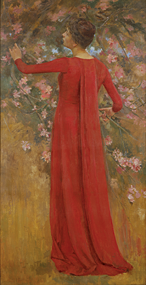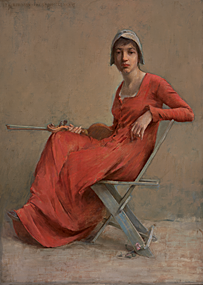|
|
 |
 |
|
|
 |
 |
Fig. 1: Theodore Robinson (1852-1896)
Giverny, 1887
Oil on canvas, 14 x 23-3/4 inches
Courtesy Adelson Galleries, New York
|
 |
In his brief yet wide-ranging career, Theodore Robinson established himself as a major figure in the early years of American impressionism, one of the only artists to work alongside Claude Monet. New York dealer Ira Spanierman, who along with the Baltimore Museum of Art's Sona Johnston is co-authoring the catalogue raisonne of Robinson's work, calls Robinson "one of the few greats" in American impressionism, an assessment backed up by the impressive prices for the artist's work, with a record auction price in excess of two million dollars.
|
Born in Irasburg, Vermont, Robinson moved to Wisconsin as a young boy, and enrolled at the Chicago Academy of Design before moving to Denver and then New York. After studying at New York's National Academy of Design and Art Students League for several years, Robinson, like other ambitious young artists of his day, sought out further instruction in Paris. Arriving there in 1876, he traveled and painted on the European continent during summers and sojourns. He came back to America for five years in late 1879.
|
 |
 |
Fig. 2: Theodore Robinson (1852-1896)
White Bridge Near Napanoch, 1893
Oil on canvas, 14-1/4 x 22 inches
Courtesy Spanierman Gallery, New York
|
 |
Returning to France for an extended period in 1884, Robinson was among the first group of American artists to paint in the now-legendary art colony at Giverny, where he became one of only a handful of foreigners to forge a working relationship with impressionist master Claude Monet. Robinson's thoughtfully structured and delicately colored canvases earned him the opportunity to paint alongside Monet, not as student and teacher, but as colleagues who by all accounts enjoyed each other's company and painting techniques, exchanging influence and critiquing one another's work. This proximity to Monet, Ira Spanierman notes, made Robinson a leading figure in the Giverny colony, a topic that was explored in the 2005 exhibition organized by the Baltimore Museum of Art and its accompanying catalogue, In Monet's Light: Theodore Robinson at Giverny; the most recent major museum exhibition to focus on the artist's work.
|
 |
 |
 |
 |
 |
Fig. 3: Theodore Robinson (1852-1896)
The Red Gown (His Favorite Model), ca. 1885
Oil on canvas,
75-1/2 x 38-1/2 inches
Courtesy Spanierman Gallery, New York.
|
 |
Fig. 4: Theodore Robinson (1852-1896)
Reverie (Young Woman
with Violin and Rose), 1886
Oil on canvas, 39-1/2 x 28-1/2 inches Courtesy Adelson Galleries, New York
|
|
In addition to his prized landscapes (Figs. 1-2), painted at Giverny and other locations throughout Europe and the United States—including Cos Cob, Connecticut; Nantucket, Massachusetts; along the Delaware and Hudson Canal in Napanoch, New York; New Jersey; and southern Vermont—Robinson also produced a number of well-regarded genre scenes, often choosing the subjects of women at work or engaged in quiet contemplation. A particularly intriguing figure who repeatedly appears in Robinson's work is a model named Marie, whom Spanierman calls the artist's "mysterious girlfriend." Though little is known about Marie, it has been speculated that Robinson may have secretly been married to her, adding mystique to the group of works in which she appears (Figs. 3-4).
|
According to Ira Spanierman, the market for Robinson's work is somewhat more complex than for some other artists, where certain subject matter or periods of production may command uniformly higher prices. With Robinson, "it's about the power of the painting itself—the light, the color, the brushstrokes," he observes. Because Robinson died at age forty-four, not a great number of his works exist—perhaps 700 in all, according to Spanierman—making his legacy all the more impressive considering the brief period in which it was built.
|
|
 |
|
Lisa Bush Hankin is director of research at Adelson Galleries in New York, where she specializes in nineteenth- and twentieth-century American fine art.
|
 |




